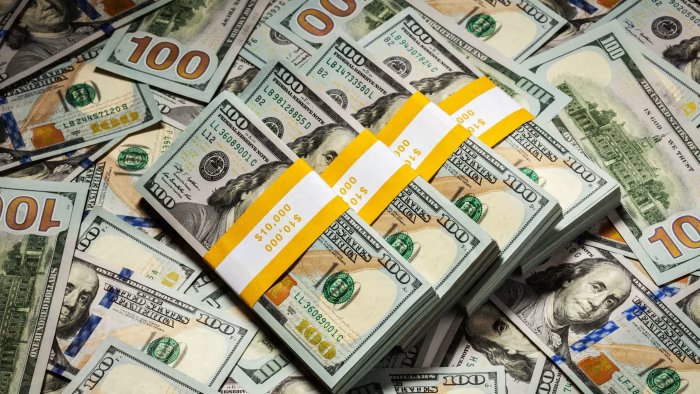Summary:
The U.S. dollar had its worst start to a year since 1973, falling over 10% in the first half, despite a recovery in U.S. stock markets and President Trump’s retreat from extreme tariff threats. The drop reflects global concerns about Trump’s trade policies, inflation, rising government debt, and weakening confidence in the U.S. as a financial leader.
Initially boosted by optimism over Trump’s pro-business stance, the dollar began sliding in mid-January after unexpected and aggressive tariff announcements shook investor confidence. Fears over long-term inflation and the impact of high interest rates further pressured the currency.
The weaker dollar makes foreign travel costlier for Americans and reduces the appeal of U.S. investments. It also raises concerns about foreign demand for U.S. government debt, especially as the country plans to increase spending, further adding to deficits.
While the dollar’s decline can benefit U.S. exporters and make imports pricier, global investors are increasingly shifting their focus to non-U.S. markets. This reflects deeper worries that the U.S. is losing its exceptional economic status, with analysts warning of a gradual shift away from the dollar as a safe haven currency.
The Dollar’s Worst Start Since 1973
The dollar is off to its worst start to a year in more than half a century. It has weakened more than 10 percent over the past six months when compared with a basket of currencies from the country’s major trading partners. The last time the dollar weakened so much at the start of the year was 1973, after the United States had made a seismic shift that had ended the linking of the dollar to the price of gold.
“This time the seismic event is President Trump’s efforts to remake the world order with an aggressive tariff push and a more isolationist foreign policy.”
Economic Concerns Weigh on the Dollar
The combination of Mr. Trump’s trade proposals, inflation worries and rising government debt has weighed on the dollar, which has also been buffeted by slowly sliding confidence in the role of the United States at the center of the global financial system.
“That means it is more expensive for Americans to travel abroad and less attractive for foreigners to invest in the United States, sapping demand when the government is trying to borrow more money.”

Tariffs and Policy Uncertainty Spark Investor Anxiety
“Even as Mr. Trump has backed down from most of extreme tariffs and the U.S. stock and bond markets have recovered from their losses earlier in the year, the dollar has continued to slide.”
“Having a weak dollar or a strong dollar isn’t the issue,” said Steve Englander, global head of G10 foreign exchange research at Standard Chartered. “The issue is: What is it telling you about how the world sees your policies?”
From Rally to Decline: Investor Confidence Fades
Initially, the dollar soared on Mr. Trump’s re-election. “Much like investors in the stock market, currency players perceived him to be pro-growth and pro-business, likely drawing in investments from around the world and raising demand for the U.S. currency.”
But enthusiasm didn’t last. “After peaking in mid-January, the dollar index began to slide. Hopes of a pro-business administration gave way to lingering worries about stubborn inflation and the impact of already high interest rates on the economy and on companies in the stock market.”
“Then came Mr. Trump’s unexpected announcement of tariffs that were far, far higher than any economist, investor or analyst had predicted, sending markets — from stocks to bonds to the dollar — into a panic.”
Also Read: Face of a 10,500-Year-Old Stone Age Woman Reconstructed from Belgian Cave Find
Global Trust in U.S. Assets Wavers
“What had begun as anxiety about inflation and the labor market became more acutely centered on the drastic effect that Mr. Trump’s tariffs could have on the entire financial system.”
“Analysts fretted about a broad shift away from the dollar and U.S. assets more broadly — a change from recent years, when the United States dominated the investment landscape and money poured into American assets.”
“I think there is a concern that the U.S. that looked exceptional is falling into the pack,” Mr. Englander said.
Trade Imbalance and the Cycle of Fewer Dollars
“Higher tariffs most likely mean lower imports, and lower imports mean fewer dollars paid to businesses overseas. That, in turn, could reduce the dollars reinvested back into the United States, in markets like government bonds, both because of the simplicity of avoiding exchanging currencies and because of the confidence investors have in U.S. markets.”
For Investors, a Shift Toward Global Opportunities
“The impacts of the dollar’s recent decline are far-reaching. The last time the dollar began a year with such a steep decline was in 1973 when foreign currencies stopped being linked to the dollar. That move came two years after President Nixon made a decision to no longer link gold to the dollar.”
“For some, this year’s weaker dollar has cut into the returns from the once again booming U.S. stock markets. The S&P 500 hit a record high last week, having rallied 24 percent since the administration backed down on much of its initial tariff plan.”
“But converting the return of the S&P 500 from dollars into euros makes the rally look a lot different, up only 15 percent and still 10 percent away from an all-time high.”
“The Stoxx 600 index, a broad measure across European stocks, has risen roughly 15 percent over the same period, but converted back into dollars that gain rises to 23 percent.”
“Already, pension funds and endowments, among other investors, have said they are looking more closely at markets outside the United States as a result.”
Debt-Fueled Doubts and Investor Caution
“Waning demand for U.S. assets stemming from tariffs has also collided with the government’s plans to increase spending, dashing hopes among some fiscal hawks that Mr. Trump would follow through on his campaign promise of decreasing government spending.”
“Despite opposition in the Senate, the bill has begun to make its way back through Congress and is estimated to add trillions of dollars to the deficit over a decade.”
“The government would make up this shortfall by looking to borrow more from investors in the Treasury market, precisely when those same investors have begun to back away, raising concerns about the stability of the market.”
“Such concerns undercut the role of both Treasuries and the dollar as a haven in periods of stress.”
Dollar No Longer a Safe Haven?
“Typically when investors are worried, they seek out assets that they are confident will hold value during periods of turmoil. But worries about the dollar have weakened it further even during volatile trading conditions, suggesting that it is not consistently playing the same haven role for investors at the moment.”
“Full-scale de-dollarization, if it ever comes, is still a long way away,” said Rick Rieder, chief investment officer of global fixed income at BlackRock, in the fund manager’s latest quarterly outlook. “But there is one dynamic playing out that could significantly raise that risk: increasing government debt.”




